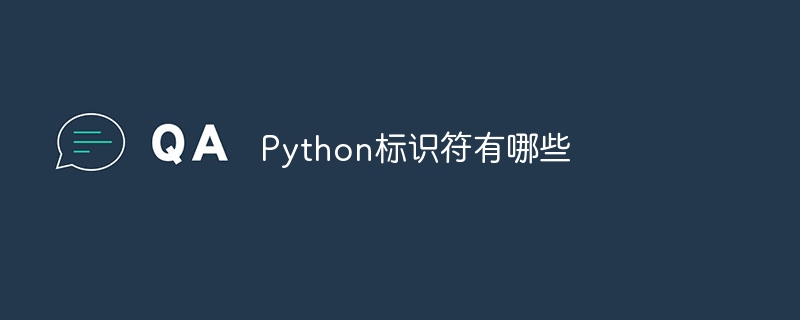
Python identifiers include variable identifiers, function identifiers, class identifiers, module identifiers, identifiers starting with an underscore, identifiers starting with a double underscore, and ending with a double underscore, integer identifiers, and floating point type identifiers, string type identifiers, list type identifiers, tuple type identifiers and dictionary type identifiers. Detailed introduction: 1. Variable identifiers, used to identify the names of variables, usually follow the underscore nomenclature; 2. Function identifiers, used to identify the names of functions, usually follow the underscore nomenclature; 3. Class identifiers, etc.

The operating system for this tutorial: Windows 10 system, Python version 3.11.4, DELL G3 computer.
Identifiers in Python are names used to identify variables, functions, classes, modules or other objects. In Python, identifiers must follow certain rules and conventions. I will introduce it in detail below Identifier rules and common identifier types in Python.
1. Rules for the composition of identifiers:
Identifiers can be composed of letters (including uppercase and lowercase letters), numbers and underscores.
The first character of the identifier must be a letter (including uppercase and lowercase letters) or an underscore (_).
The identifier cannot start with a number, but it can contain numbers.
Identifiers are case-sensitive, that is, uppercase and lowercase letters are different identifiers.
The identifier cannot be a Python keyword (reserved word) or the name of a built-in function.
2. Universal identifier specification:
Variable identifier: a name used to identify a variable, usually follows Underscore nomenclature (snake_case), such as "first_name", "user_age".
Function identifier: used to identify the name of the function, usually following the underscore naming method (snake_case), for example "calculate_average", "print_message".
Class identifier: used to identify the name of the class, usually following CamelCase naming method (CamelCase), that is, the first letter of the word is capitalized, such as "CarModel", "PersonInfo".
Module identifier: used to identify the name of the module, usually using all lowercase letters, such as "math", "random".
3. Special identifiers in Python:
Identifiers starting with an underscore: starting with a single underscore Identifiers usually represent private properties or methods, such as "_hidden_variable", "_private_method".
Identifiers starting with a double underscore and ending with a double underscore: Identifiers starting and ending with a double underscore are built-in identifiers, such as "init", "len". This naming convention is used to avoid conflicts with user-defined identifiers.
4. Type identifier:
Integer identifier: used to represent integer values, such as "num1 ", "count".
Floating point identifier: used to represent floating point values, such as "price", "average".
String identifier: used to represent string values, such as "name", "message".
List type identifier: used to represent list objects, such as "data_list ", "result_list".
Tuple type identifier: used to represent tuple objects, such as "info_tuple", "data_tuple".
Dictionary identifiers: used to represent dictionary objects, such as "user_info", "config_dict".
In Python, good identifier naming conventions and conventions are important for code readability. Readability and maintainability are very important. Adopting standardized identifier naming can make code easier to understand, share, and maintain.
The above is the detailed content of What are Python identifiers?. For more information, please follow other related articles on the PHP Chinese website!




